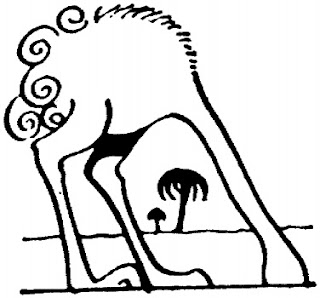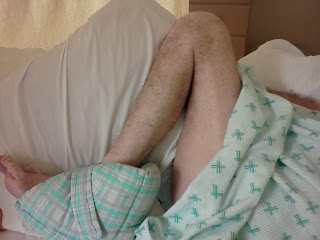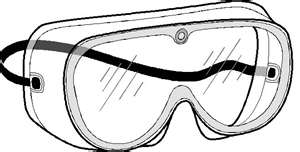Back to my blog home page: http://travelingotr.blogspot.com
Today, I want to write about a lurking beast among residents of skilled and long term care.
Joint Contractures...
Many therapists are a little intimidated by joint contractures.
As a result, it's like
if you don't go looking for them in the building, you'll keep on working with your Med A rehab-to-home patients and never address the issues of the long term folks.
However...
If we're going to do a great job, we have to serve everyone.
(even those tough-to-treat long-term residents with contractures.)
Better yet...
let's keep them from getting contractures
in the first place!
If you're a lay person reading this, contractures are the chronic loss of joint motion due to structural changes in non-bony tissue. These non-bony tissues include muscles, ligaments, and tendons.
Contractures may be caused by:
- Neurological insult (i.e. brain injury, stroke)
- Progressive neurological diseases (i.e. Parkinson's Disease, Multiple Sclerosis)
- Severe cognitive decline (dementia) leading to inactivity
- Birth defects caused by disease or anoxia (lack of oxygen) during birth
- Leprosy (yes, leprosy, not in this part of the world, but others!)
What do contractures look like?
Severe hip and knee contractures
Moderate elbow and wrist contractures
How do you keep a person from getting contractures?
Simple! Keep the person moving. Every joint.
That means...EXERCISE, WALKING and P/AAROM (passive or active assistive range of motion)....
To Figure Out Who Has Contractures in the Building
2) Check the Minimum Data Set, MDS, which is usually in the resident's chart or at a large binder at the nurses' station. Check the ROM section to see if contractures have been documented. This will tell you where and how severe the loss is that nursing has documented. Honestly, this section is wrong half the time. It is up to us to communicate the correct info on ROM to the MDS coordinator so it can be corrected.
3) Talk to the nurses' aides and find out where the resident has difficulty (transfers, standing during clothing management/toileting, dressing upper or lower body, or rolling in bed to have brief changed)
If a person already has a contracture, here's how to treat it:
- Make sure nursing staff have documented any functional changes, increase in assistance required by aides or loss of ROM. In addition, Activities, RNA or dietary can also document loss of function (i.e. decreased ROM during rhythm band, tighter mm during ROM from RNA, increased instability when walking due to bent knees, or difficulty with bringing hand to mouth during meals).
- Request the order/evaluate.
- Evaluate when the doctor's order arrives.
Evaluation must always related to function or medical condition. Is the person struggling to get dressed, hold a fork during meals, stand up fully or walk down the hall?
If the person is bedbound and unable to participate in functional activity, the reason for the evaluation then relates to decreasing caregiver burden, protecting skin integrity, managing pain or promoting joint integrity to provide care, such as dressing or peri hygiene.
Just because someone cannot move and participate in daily activities does not mean they are not a candidate for therapy.
(We must shift the way we think!)
1) Make sure you measure all joints, even the ones you have not been requested to evaluate. OTs, I also do knee splinting for positioning in the bed or wheelchair, especially in cases like the photo of the guy above, because he's going to have a pressure area on his butt if the knee contractures are not reversed.
2) Relate the ROM measurements to functional loss or consequence if the contracture is not reversed.
3) Write the goals in small increments so you can demonstrate improvement.
4) Use the correct ICD-9 codes!
718.4_ (joint contracture)
(The fifth digit must be one of the digits below)
0 site unspecified
1 shoulder region
2 upper arm
3 forearm
4 hand
5 pelvic region and thigh
6 lower leg
7 ankle and foot
8 other specified sites
9 multiple sites
Contractures also cause joint pain (719.4_). Follow the same instruction for the fifth digit of the code above.
Other related codes could include abnormal posture 781.92 caused by contracture formation, difficulty feeding 783.3, and difficulty walking 719.7 (among others!! Look at your eval when it's written before you print. It will give you all the answers.)
Treatment Tools:
Goniometer
Measure each joint!
Your Hands
Your hands can help heal a person's contracture formation. The only way to learn and become a master at normalizing muscle tone is to practice on people who have high muscle tone. The shifts are so subtle when working with high tone that you must work very slowly while watching for nonverbal (facial grimace, whole body withdrawal, pulling the limb away) or verbal signs of pain or discomfort.
What to do....gentle rocking, gentle shaking, cross friction massage over the muscle insertions, deep yet controlled pressure over tendons, slow stretching, myofascial release....get to know what works with your touch.
Estim
If the contracture is caused by hypertonic muscles, choose e-stim (PENS, or Patterned Electrical Neuromuscular Stimulation) to treat the tone prior to splinting. I recommend contacting ACP for information on their continuing education if you have not used modalities.
Diathermy
If the contracture is caused by tightness at the muscle insertion, use the diathermy. I usually use this on the bicep and hamstring insertions.
Orthotics
Splints aren't something you can just slap on and wear for 6 hours a day. I start with 15 minutes and increase in 15 minute increments with observation following fitting, making modifications as necessary for comfort. If the person is in pain, they will not wear the splints, and that takes you back to
Square One.
This is the "big picture" of contracture management, and there are so many more moving parts that this could run too long.
If you have questions, send me a comment or an email!


























 k
k r)
r)
















